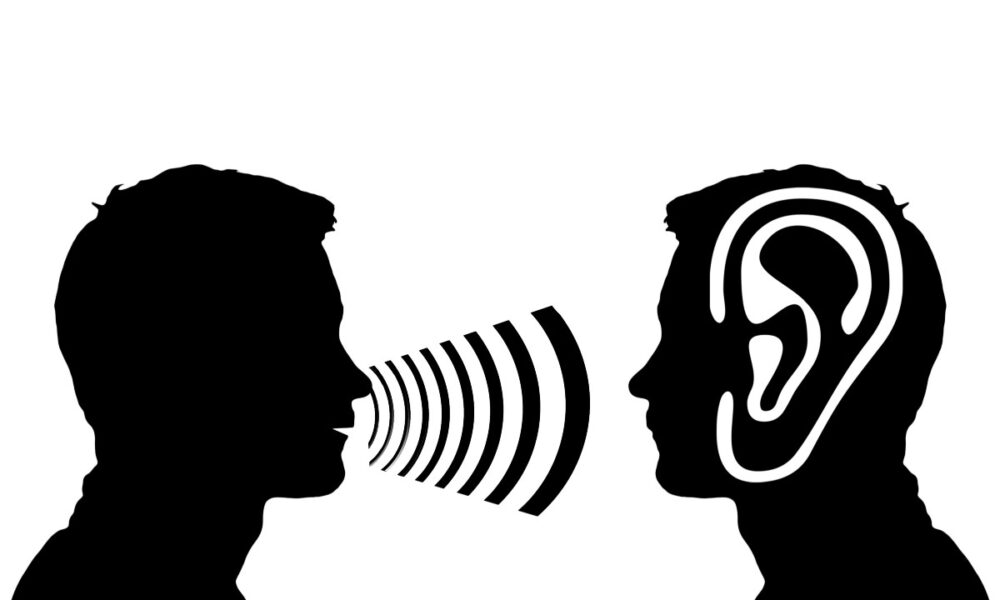
I believe that being a good listener is a crucial element in becoming a good conversationalist.
Listening and actively listening are abilities that we all need to learn. Consider a world in which people not only listen physically (the sound enters their ears) but also hear each other to understand what the other person is saying. That would be a great world in which everyone is an attentive listener.
Why does being a good listener an important element in being a good conversationalist?
I will answer it with a quote by Maya Angelou, I think she puts it perfectly well when she said:
“People will forget what you said, people will forget what you did, but people will never forget how you make them feel.”
Flying Star


This statement is a wonderful example of why you must be a good listener. By being a good listener, you make the other person feel good about themselves, you allow them to speak up, you listen to them, and you care about them.
That is why, throughout a conversation, it is more vital to listen than to speak. So what essentially happens when you’re an active listener, is your conversation just flows because you’re able to interact with the other person with a kind of discourse that’s authentic, sincere, and shows that you care. They’ll never forget how they felt in your presence, and they’ll always say they had a wonderful talk with you. I’d want to point out that the majority of these suggestions can be applied in both in-person and over-the-phone talks. Not all, but the majority, can be utilized.
There are two components to being a good listener.
1. Non-Verbal Signs
This is also known as body language. The way we hold ourselves, the way we stand and express our emotions through our face and body.
Tip #1: SMILE
Remember that when you’re in a business meeting or a conference, you’re more likely to approach someone who smiles at you. Because a smile indicates to the other person that you welcome them into your world. It puts the person at ease, it welcomes them, and it makes you look more amicable, and approachable which is a great thing if you want to meet more people.
Again, be aware when you are smiling throughout the conversation because it may not be suitable at times, or it may appear that you are faking it. So, smile, especially at the start, but use it sparingly during the conversation.
Tip #2: EYE CONTACT
This demonstrates that you are giving someone your undivided attention, that you are present and looking into their soul – into their story. We say that our eyes are the windows to our soul, and it’s true. We prefer to glance away from something when we are hiding or are uninterested.
So when you are listening, make sure that you maintain eye contact but do so moderately so that you don’t put tension on the person you’re having a conversation with.
When they’re telling you their story, they can feel uncomfortable if you just stare at them. Look aside for a moment to their cheek, lips, or forehead, then back into their eyes.
If staring into someone’s eyes makes you feel awkward, either because you are shy or because you were raised in a culture where looking into someone’s eyes was frowned upon, I recommend gazing in between the brows, near the top of the nasal bridge. If you stare in there, it may appear that you are looking into their eyes, but you are not. This provides the idea that you’re looking them in the eyes.
Tip #3: OPEN POSTURES
- Your bodily movements are important. Primarily, if you want to appear to be an engaged listener, make an effort to become closer to the person you’re listening to. Lean in and bring your body closer together. Demonstrate that you are not only cognitively but also physically present.
- Maintain an open body position and avoid crossing your hands or closing yourself off from the person you’re talking to or listening to. Because doing so physically separates you from the other person. Make sure your hands and chest are open, and that you are open to their story.
- The location of your head is another key aspect of posture. If you tilt your head back and slant it to the side, it may appear like you’re bored and uninterested in what they’re saying. So you maintain your slanted head position while moving in closer. This physically puts your ear closer to the individual, indicating that you are listening and hearing what they are saying.
- Another option is to rest your head on your hand. As a result, you should appear more calm and ready to hear and all accessible to truly listen to them, your thoughts are engaged in what the person is saying.
Tip #4: NOD
Depending on the message you’re hearing, move your head up and down or side to side.
For example, if someone claims they feel undervalued at work and are not driven, this is unfair and unjust. You might repeatedly move your head from side to side, as if to say, “I hear what you mean, this is so unfair and wrong.”
On the other hand, if they claim they’re really excited and have an opportunity at work. You can move your head up and down as if to say, “Yes, I agree with you.” Nodding or moving your head from side to side may represent the messages you’re receiving.
Tip #5: MIRRORING
It reflects the individual’s body posture or position. This is vital not only when speaking, but also when listening.
For example, someone is telling you a story and gradually and steadily leaning in. If they are crossing their arms for any reason, slowly and steadily adjust that to your own body language. This establishes a kind of rapport between you and the other person.
2. Verbal Signs
Let’s look at some of the things we can do verbally, in order to reinforce the image of a good listener.
Tip #1. POSITIVE REINFORCEMENT WORDS.
“Yes.” “Right.” “I hear you.” “I feel you.”
These words help the person think that you are listening to him and understand what he is saying. It’s critical that you make the person feel heard. When having an in-person chat, use it sparingly with body language strategies such as nodding. You can switch between the two so that your words do not constantly interrupt the speaker.
When speaking on the phone, I suggest using more positive reinforcement words because they can’t see you or nod, so you can use a few more words like these.
Tip #2. QUESTIONING
This means follow-up questions to the story they’re sharing.
Be cautious when questioning the person because you don’t want to ask too intimate questions or appear to be interfering with their story. You can ask for clarification on particular things that were discussed, therefore you may ask a follow-up question.
You don’t have to interrogate them and flood them with interview questions.
Tip #3. REFLECTION
Repeating and paraphrasing what the speaker says to demonstrate that you heard and comprehended what they said. This demonstrates that you are paying attention and taking in their story.
What you’re doing is reflecting their story, giving them the impression that you heard and felt their feelings, and demonstrating that you’re observing, processing, and reflecting their message back to them.
Tip #4. CLARIFICATION
Clarify certain points by asking open-ended questions which are not answerable by yes or no.
Tip #5. SUMMARIZATION
Provide a summary of what you’ve been told in your own words. Add a question at the end to show that you genuinely listened to what they said and to move the conversation ahead.
Tip #6. LISTEN TO THE TONE OF THE VOICE
The tone conveys more information than the words. We can sometimes learn our topic and speech, but it’s difficult to control our tone. So, if you can tune in to the speaker’s tone of voice, you can learn a lot more than just the speech.
. . .
All of these are significant. Overall, these will help you become a better listener. These methods and tips, though, may overwhelm you. But don’t think you have to practice all of these things at once to become a good listener.
Alternate between a few of these tips, focusing on what seems most organic or natural to you. I guarantee you that this will become a habit for you with time. An intriguing study in psychology concluded that people most commonly like conversations while they are talking because people prefer to hear their own voices and to be heard. So, if you want to be a good conversationalist, learn to listen well.

Email Etiquette
“ Today, we can't imagine our lives without email. We wake up responding to an email. We go to bed responding to.

COFFEE ETIQUETTE
HISTORY There are two stories about the discovery of coffee beans and their origin. According to one legend, they were discovered by.

